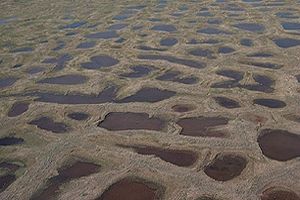Extremophiles: Difference between revisions
| Line 1: | Line 1: | ||
== Overview == | == Overview == | ||
An Extremophile is an organism that experiences optimal growth in environments outside the realm of what is considered “normal” and may even require intense geochemical or physical conditions to survive [1]. Extremophiles associated with plants encompass all three domains of life: Archaea, Bacteria, and Eukarya. Within these domains, they can be found in different phylums and groups such as Actinobacteria, Ascomycota, Bacteroidetes, Basidiomycota, Crenarchaeota, Euryarchaeota, Firmicutes and Proteobacteria. | [[File:Permafrost_-_polygon.jpg|thumb|description]] | ||
An Extremophile is an organism that experiences optimal growth in environments outside the realm of what is considered “normal” and may even require intense geochemical or physical conditions to survive [1]. Extremophiles associated with plants encompass all three domains of life: Archaea, Bacteria, and Eukarya. Within these domains, they can be found in different phylums and groups such as Actinobacteria, Ascomycota, Bacteroidetes, Basidiomycota, Crenarchaeota, Euryarchaeota, Firmicutes and Proteobacteria. Extremophilic microbes that benefit plant health and soil fertility are [[Arbuscular Mycorrhizal Fungi]] and bacteria found in the [[rhizosphere]] growing under abiotic stress conditions of temperature, salinity, pH and water deficiency. These microbes are said to be psychrophiles (-2°C to 20°C), thermophiles (60°C to 115°C), halophiles (2-5M), acidophiles (pH<4), alkaliphiles (pH>9) and xerophiles (water potential 0.75 kPa) [2]. Though not intensively studied until recently, extremophiles may have huge potential in the application of agriculture, biotechnology and bioremediation [3]. | |||
==Agriculture== | ==Agriculture== | ||
Revision as of 22:57, 5 May 2019
Overview

An Extremophile is an organism that experiences optimal growth in environments outside the realm of what is considered “normal” and may even require intense geochemical or physical conditions to survive [1]. Extremophiles associated with plants encompass all three domains of life: Archaea, Bacteria, and Eukarya. Within these domains, they can be found in different phylums and groups such as Actinobacteria, Ascomycota, Bacteroidetes, Basidiomycota, Crenarchaeota, Euryarchaeota, Firmicutes and Proteobacteria. Extremophilic microbes that benefit plant health and soil fertility are Arbuscular Mycorrhizal Fungi and bacteria found in the rhizosphere growing under abiotic stress conditions of temperature, salinity, pH and water deficiency. These microbes are said to be psychrophiles (-2°C to 20°C), thermophiles (60°C to 115°C), halophiles (2-5M), acidophiles (pH<4), alkaliphiles (pH>9) and xerophiles (water potential 0.75 kPa) [2]. Though not intensively studied until recently, extremophiles may have huge potential in the application of agriculture, biotechnology and bioremediation [3].
Agriculture
Extremophilic microbes found in soils and within plants present a of variety of benefits towards increasing overall plant health. They have ability to produce phytohormones, solubilize nutrients, and attack pathogens. There has been success in applying these microbes as biofertilizers for crop improvement and soil health as a sustainable option[2]. Two rhizobacteria root endophytes that are found in Antarctica, Penicillium chrysogenum and Penicillium brevicompactum, increased fitness in cayenne, lettuce, onion, and tomato in high salinity environments by limiting the intake of salt. This has useful application in reduction of saline stress on plants that are not saline tolerant, such as lettuce [4]. In another study, endophytic mycorrhizae isolated from the roots of a tomato grown in intense drought and saline conditions was found to activate and stimulate defense mechanisms within plants to achieve improved growth [5]. There is an extreme interest in extremophilic microbes found in cold environments due to their ability to thrive in what is often a high salinity and arid environment, but full potential of these microbes in agriculture is still being discovered and researched, for example the recent increase in the reports of acidophiles found in plants growing within acidic soil [2].
Bioremediation
Biotechnology
Refrences
[1] Rampelotto P. H. (2013). Extremophiles and extreme environments. Life (Basel, Switzerland), 3(3), 482–485. doi:10.3390/life3030482
[2] Yadav, Ajar Nath. (2017). Beneficial role of extremophilic microbes for plant health and soil fertility. Journal of Agricultural Science and Botany. 1. 1-4.
[3] Kristjánsson, J.K. & Hreggvidsson. (2017). G.O. World Journal of Microbiology & Biotechnology 11: 17. https://doi.org/10.1007/BF00339134
[4 ]Acuña-Rodríguez Ian S., Hansen Hermann, Gallardo-Cerda Jorge, Atala Cristian, Molina-Montenegro Marco A. (2019). Antarctic Extremophiles: Biotechnological Alternative to Crop Productivity in Saline Soils. Frontiers in Bioengineering and Biotechnology. 22.
[5] Khan, A.L., Waqas, M., Khan, A.R. et al. World J Microbiol Biotechnol (2013) 29: 2133. https://doi.org/10.1007/s11274-013-1378-1